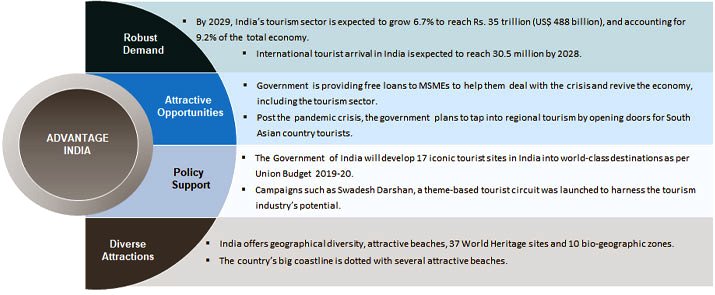Indian Economy
Tourism Sector In India
- 20 Jan 2021
- 6 min read
This article is based on “In our past lies our future… Indian tourism hasn’t marketed the precious assets embedded in our heritage to full potential” which was published in The Times of India on 19/01/2021. It talks about the constraints & opportunities associated with the tourism sector in India.
The outbreak of the Covid-19 pandemic last year has brought almost all areas of the business to a standstill. Arguably, the worst affected has been the tourism and hospitality industry, which had to bear the brunt of lockdowns and social distancing.
According to the UN World Tourism Organization (UNWTO), this is by far the worst crisis international tourism has faced since records began in 1950.
Now as the vaccines are available, life will return back to normalcy. Given this, India should seek to actively support the tourism sector, as the sector contributes an estimated 10% to the Indian economy and is our biggest ambassador to the world.
Further, India has inherent competitive advantages as it offers a diverse portfolio of niche tourism products - cruises, adventure, medical, wellness, sports, eco-tourism, film, rural and religious tourism. This competitive advantage will help India become a tourism hub in the world.
Constraints in Tourism Sector
- Infrastructure and Connectivity: Deficiencies in infrastructure and inadequate connectivity hamper tourist visits to some heritage sites.
- Also, India has various tourist destinations but few circuits or segments such as the Golden Triangle (Delhi-Agra-Jaipur).
- Promotion and Marketing: Although it has been increasing, online marketing/branding remains limited and campaigns are not coordinated.
- Tourist information centers are poorly managed, making it difficult for domestic and foreign tourists to access information with ease.
- Lack of Skills: The number of adequately trained individuals for the tourism and hospitality sector is a key challenge to giving visitors a world-class experience.
- A limited number of multilingual trained guides, and the limited local awareness and understanding of the benefits and responsibilities associated with tourist growth act as constraints on the sector’s growth.
- Underutilization of Tourism Potential: Out of 140 countries, India ranked 8th on cultural resources and business travel, 13th on price competitiveness, and 14th on natural resources in World Economic Forum’s Travel & Tourism Competitiveness Report 2019.
- Despite these superb rankings, India’s overall tourism competitiveness ranking at 34 reveals that India has not monetized or marketed the precious assets embedded in its heritage to their full potential, as other countries do.
Way Forward
- One India One Tourism’ Approach: Tourism encompasses multiple ministries and takes place in and within states.
- It thus requires a National Tourism Council, an empowered legislative body that will enable fast-tracking of Centre-state level tourism matters and will create a ‘One India One Tourism’ approach.
- Tourism Should be Declared as Infrastructure: Tourism infrastructure projects, viz., hotels, resorts, equipment, parks, etc., having a project cost more than Rs. 1 crore should be notified as ‘infrastructure’ to enable promoters to avail loans on a priority basis.
- Skill Development: There is a need to connect local communities to tourism by encouraging them to set up small enterprises to supply the tourism industry.
- Employment opportunities can be expanded by ensuring that investors and operators in the organized sector are encouraged to hire staff locally
- Conservation of Heritage Sites: Conservation and development of all heritage sites should be undertaken and completed through either government funding or through NGOs/Corporate Social Responsibility (CSR) activities.
- The Ministry of Tourism’s Swadesh Darshan and National Mission on Pilgrimage Rejuvenation and Spiritual Heritage Augmentation Drive (PRASHAD) schemes are already undertaking the development or maintenance of heritage sites.
- Promoting Ease of Tourism: To truly ensure a seamless tourist transportation experience we need to standardize all interstate road taxes and make them payable at a single point which will facilitate the ease of doing business.
- Incredible India 2.0: Given the diversity of tourism in India, there is a need to actively promote and market niche tourism like Buddhist circuit, Swadesh Darshan, Adventure tourism in Andaman and Nicobar Islands.
- In this context, the Government of India can launch the Incredible India 2.0 campaign, which will promote tourism in 100 Smart & Swachh Tourist Destination Sites.
Conclusion
Given opportunities in the Tourism sector, it can act as an engine to revive growth and showcases brand India to the world.
|
Drishti Mains Question Given opportunities in the Tourism sector, it can act as an engine to revive growth and showcases brand India to the world. Discuss. |
This editorial is based on “Whatever it takes: On govt. powers to combat vaccine hesitancy” published in The Hindu on January 19th, 2020. Now watch this on our Youtube channel.







